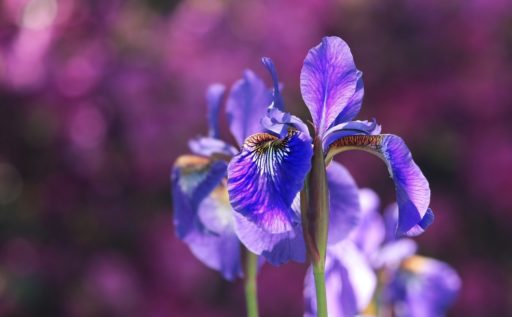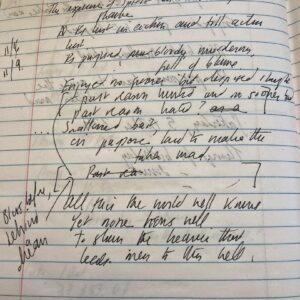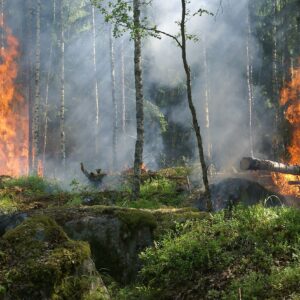In my part of the country, spring is trying to spring forth. The fresh young greens outside move me to go (inside) to my computer, where I have a folder chock-full of favorite poems. I scroll through for poems that speak in some way or other about springtime: especially the blossoming of flowers or the emergence of green shoots or the headiness of spring scents.
What secret purple wisdom tells the iris edges to unfold in frills? What juiced and emerald thrill urges the sap until the bud resolves its tight riddle?
This is Luci Shaw, in “What Secret Purple Wisdom” (from The Angles of Light). Spring’s openings are what she images here: the iris unfolding in frills; the bud untightening.
An opened bud is key, too, for Kathleen Norris, in “Body and Blood” (from Journey: New and Selected Poems 1969-1999). Her speaker is taking a walk at dawn, “worn, spent, / torn with sorrows,” when the sight of a bee dipping into a blossom becomes unexpectedly restorative:
Stupid with worry, worries — and they are legion — I stop to admire the weedy hollyhocks by a neighbor’s backyard fence.
I hear the bumblebee before I spot him entering a blossom, his body quivering like an infant’s mouth at the breast, drinking the milk of the world.
That expansiveness (“drinking the milk of the world”) is celebrated in a very different tone in Lucille Clifton’s “roots” (from An Ordinary Woman), which glories in the wildness of actually becoming spring’s life:
call it our craziness even, call it anything. it is the life thing in us that will not let us die. even in death’s hand we fold the fingers up and call them greens and grow on them, we hum them and make music. call it our wildness then, we are lost from the field of flowers, we become a field of flowers.
That “life thing in us” generates new green from our fingers; spring’s energy surges in us till “we become / a field of flowers.”
Jane Hirshfield’s “Bobcats, Beetles, Owls” (from Given Sugar, Given Salt) conveys the very opposite of Clifton’s “wildness”: a moment of evening stillness in jasmine’s scent:
We stood in the dark outside a door and talked in the scent of jasmine.
Three women standing at the foot of—what? One mountain of three lifetimes’ lucks and losses, the other actual and breathing, above us in the dark.
The year’s new leaves and grasses were resting all around us. Somewhere above us, deer were sleeping. Bobcats, beetles, owls were sleeping.
We spoke of neither mountain. We breathed in the scent of jasmine between words whose meaning didn’t matter. Only the murmur mattered, going on.
It was night. Deer slept, and bobcats. Our lives paused with us in the doorway, waiting.
“The year’s new leaves and grasses were resting all around us.… / We breathed in the scent of jasmine between words… / Our lives paused with us in the doorway, waiting.” Hirshfield gives us the hush of a spring night.
The final stanza of Pattiann Rogers’s “Vanilla” (from Generations) is also quiet…with the richness of detail characteristic of her poetry:
Remember, it is into the vortex of the white orchid of V. planiforia (from which comes the vanilla bean and its sensual oils), it is upon the soft fluted lips of that flower and into the deep funnel of its elaborate spread that the truly devout servant must place ears, mouth, tongue, fingers, so as to receive fully into the vortex of the soul all messages of transcendence inherent to that hallowed space.
The pull here into the “fluted lips of that flower” recalls Kathleen Norris’s bumblebee “entering a blossom, / his body quivering / like an infant’s mouth at the breast.” But for Rogers, it is we — if we’re “the truly / devout servant” — who must enter the flower’s “vortex.” And why? So that “the vortex of the soul” can “receive fully… / all messages / of transcendence inherent to that hallowed space.”
With “devout,” “soul,” “transcendence,” and “hallowed,” Rogers has taken us someplace new: into the transcendent realm. What’s extraordinary about Rogers — and this is typical of her poems — is that the most earthly of things (here a “white orchid”) can hold within it a “hallowed space.”
Galway Kinnell does something a bit similar in the opening lines of “Saint Francis and the Sow” (from Three Books), though here — unlike all the other poems above — the “bud” and “flower” are metaphors:
The bud stands for all things, even for those things that don’t flower, for everything flowers, from within, of self-blessing…
All things, all people — “everything”— flowers from within. There’s such profound hope in this humble image. And even more so as it’s reinforced by the lovely faith-filled concept of “self-blessing,” evoking an inner hallowedness suggestive of Pattiann Rogers’s “vortex of the soul.”
Rogers’s other “vortex” — of her flower, “the white orchid ” with its “soft / fluted lips” —brings me back to the poem I began these reflections with: Luci Shaw’s “iris edges” unfolding “in frills.” And in fact, the closing lines of Shaw’s poem picture spring, as Rogers does, throbbing with transcendence:
Listen close — what silver sound thaws winter into spring? Speaks clamor into singing? Gives love for loneliness? It is this unterrestrial pulse, deep as heaven, that folds us in its tingling embrace, gongs in our echo hearts.
Yes, “listen close.” You’ll hear, you’ll feel, spring’s essence: its “unterrestrial pulse, deep as heaven.”
Peggy Rosenthal has a PhD in English Literature. Her first published book was Words and Values, a close reading of popular language. Since then she has published widely on the spirituality of poetry, in periodicals such as America, The Christian Century, and Image, and in books that can be found here.





